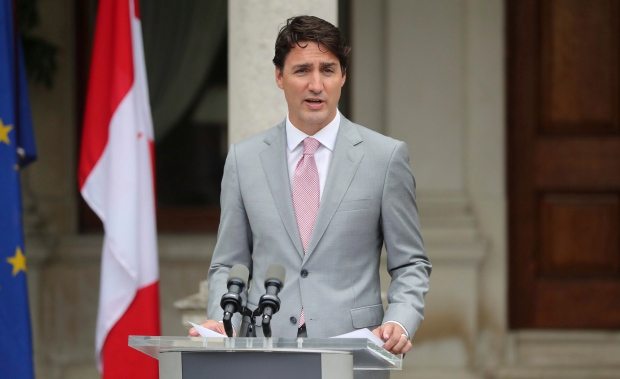3 Canadians make modern splash at Venice Biennale, while Pootoogook becomes 1st Inuit artist to show – World


Untitled by late Cape Dorset Inuk artist Kananginak Pootoogook. He is the first Inuit artist ever to be displayed at the Venice Biennale. (Megan Williams/CBC)
It’s tempting to say that Canada has pulled off an artistic hat trick at the Venice Biennale – with three living artists scoring deep, complex works that explore everything from repressed trauma to the fading of religious ecstasy.
But that would be overlooking a fourth – and perhaps the most significant – artist on show on the main spaces of one of the world’s most important art exhibitions.
That is Kananginak Pootoogook of Cape Dorset, Nunavut. Almost seven years after the influential Inuk sculpture and printer’s death, he is the first Inuit artist ever to be displayed at the Biennale after his works were selected by French curator Christine Macel for show in the Arsenale (the former shipyard).
Tucked among the array of post-modernist takes on everything from Michelangelo’s David to balls of wool, Pootoogook’s depictions of Inuk life still emanate bare emotion and human warmth. They are works free of irony that quietly stand their ground among the visual cacophony of contemporary art.
Official Canadian artist Geoffrey Farmer
If Pootoogook himself was not present, his spirit infused the work of Canada’s official artist in this 57th Biennale, Geoffrey Farmer’s A way out of the mirror installation.

Vancouver’s Geoffrey Farmer, left, shown talking to Finance Minister Bill Morneau, is the official Canadian entrant to the Biennale. (Megan Williams/CBC)
“Cape Dorset plays such a major role in Canadian art and as an artist I’ve been so influenced by that art,” says Farmer, who, at 50, is a youthful-looking man who speaks slowly and carefully.
Some inspiration came from his visit to the famed artist studio in Nunavut after the school burned down in 2015.
Farmer met with the school principal, an encounter that led to his promise to donate proceeds from a possible sale of his works to help rebuild the school library.
“[That experience] is also an expression with this building, that I’m opening up to the world in a new way,” said Farmer, who uses water as an analogy for themes of repressed grief and trauma that ripple through generations.

Vancouver artist Geoffrey Farmer’s watery exploration of repressed grief and trauma A way out of the mirror is shown in the Canadian pavilion. (Megan Williams/CBC)
Farmer, already internationally renowned for his manic magazine cut-out works, has transformed Canada’s cramped wooden pavilion in Venice with erupting, spraying and dripping water to express his themes.
Its angular roof is gone and in the middle, a geyser-like fountain ringed with splayed lumber jets water up past the roof beams into the towering trees above.
A photograph Farmer’s sister sent him of a collision between a train and a lumber truck, with planks scattered about, sparked the project. Missing from the photo was his grandfather, the driver, who died shortly after the crash, an incident his own father never mentioned.
“There had been a lot of unprocessed grief,” he says. Farmer says the work is part of his effort “to understand my father in a more intimate way and to have empathy for him and what he went through.”
That process eventually eased his strained relationship with his dad as a young gay man wanting acceptance, he says.
Hajra Waheed explores migrants’ journeys
If personal narrative ignites Farmer’s work, storytelling drives Montreal-based artist Hajra Waheed’s haunting exploration of migration, part of a larger project called Sea Change.
At the invitation of the Biennale’s curator Macel, Waheed assembled five different works, ranging from postcard cutouts of granite mountains inserted in glass slides – what Waheed calls A Short Film – to small oil paintings on tin depicting outstretched hands, fish and the night sky at sea, a sombre and beautiful conjuring of the migrant’s lonely journey.

Works from the life-long project called Sea Change by Montreal artist Hajra Waheed are showing in the main pavilion of the Venice Biennale. (Megan Williams/CBC)
Waheed, who was born in Canada of South Indian descent and who grew up in Saudi Arabia, says the work is part of a life-long “visual novel” or meditation begun six years ago and composed of hundreds of works. It involves nine protagonists who at some point all get lost at sea. So far, she is on the first character, a geologist in search of quartz crystal.
“There a certain sense of timelessness to the work and imagery,” Waheed explains, her effort to make sure people don’t try to pigeon hole the work with one particular meaning.
The idea came about when in 2011 she read about 166 pilgrims from Kolkata, India, to Mecca who disappeared before returning home.

Sea Change by Montreal artist Hajra Waheed is an exploration of the migrant experience, including hours at sea. (Megan Williams/CBC)
“Here were 166 people who just went missing. Was it in the name of salvation? A better life or a new one? How did this disappearance occur?” she asks.
She also reflects on the news of migrant drownings in the Mediterranean and elsewhere. “And the numbers of people drowning are so large and we are so hyper-saturated and yet are completely numb to it and feel hopeless in the face of it.”
She says using art to connect to individual stories of migration is worth dedicating a lifetime to.
Jeffrey Shaw reflects on altered states
In the nearby Arsenale section of the Biennale, Berlin-based Vancouver-raised artist Jeremy Shaw offers his own mesmerizing fictional narrative.
His 20-minute sci-fi video at first seems like a 1970s BBC documentary following hippies seeking spiritual enlightenment through tribal dance and Ashtanga yoga. Flying hair and sweat abound.

A scene from Jeffrey Shaw’s The Liminals. (Megan Williams/CBC)
Through a male voice-over, we learn we’re some time in the future and that the human race is dying because we have allowed the part of the brain where faith resides to atrophy, not realizing it was key to our survival. The dancing hippies, called The Liminals, are renegade altruists trying to revive that lost capacity to save humanity.
Then, toward the end, a club beat kicks in, the dancing transforms to raving and the images turn psychedelic. The links between religion and drugs are writ large.
Accompanying the video are photos of people experiencing religious rapture with a transparent kaleidoscopic acrylic plate placed on top.

Berlin-based Vancouver artist Jeremy Shaw at the Venice Biennale explores euphoria and the inability to express it in art. (Megan Williams)
“I’ve always been very interested in how we choose to represent people in these supposed altered states,” says Shaw, who last year won the prestigious Sobey Art Award . (Fellow artist Hajra Waheed was a finalist.)
“It’s undocumentable, the translation of the experience to the visual form,” he says, leading him to combine documentary material with visual devices, tropes and clichés around “altered experience” to experiment.
Shaw says his fascination with altered states dates back to the first time he dropped acid at age 13.
“These transcendental moments defy language and capable representation. Anything profound does,” he adds. “Even love.”
Source link

